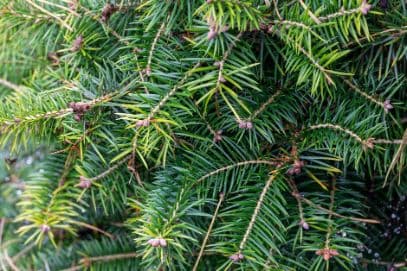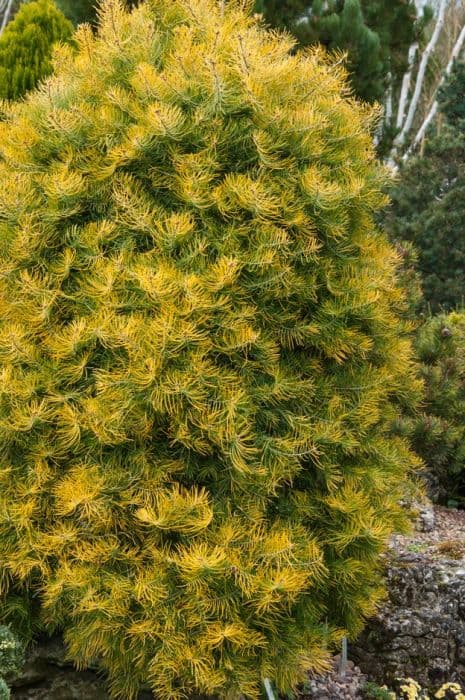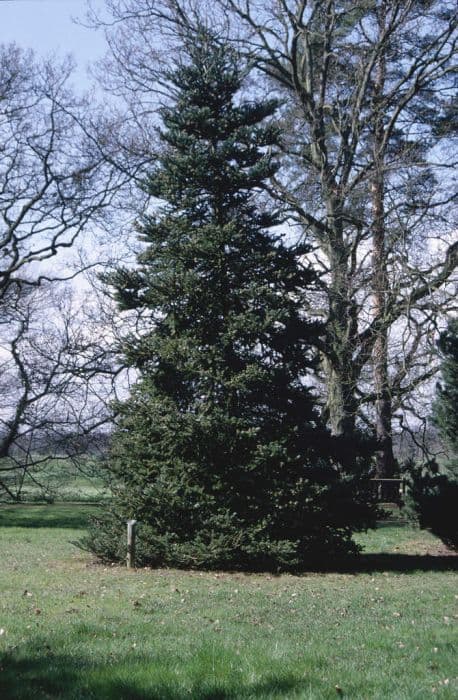Eastern Hemlock Tsuga canadensis

ABOUT
Tsuga canadensis, commonly known as the Canadian hemlock, is a coniferous tree that is characterized by its graceful and fine-textured foliage. The tree bears leaves that are needle-like in shape, soft to the touch, and a rich, deep green in color. The needles are typically short, arranged in two ranks on the branches, giving the boughs a feathery appearance. This delicate arrangement results in a pendulous or weeping effect, especially as branches mature. The bark of the Canadian hemlock is initially smooth and gray when the tree is young. As it ages, the bark turns a reddish-brown color and develops deep furrows and ridges, becoming quite rough. These trees produce small, light brown cones that hang from the branch tips. Each cone is only a few centimeters long and offers a contrast to the lush greenery of the needles. Structurally, the Canadian hemlock exhibits a pyramidal shape with a broad base and a narrow, tapered top. The horizontal branches swoop downwards and then slightly up at the tips, which contributes to its softly rounded silhouette. With its rich, textured foliage and distinctive cones, this tree has a classic evergreen appearance that is representative of many plants in northern climates.
About this plant
 Names
NamesSynonyms
Eastern Hemlock, Canadian Hemlock.
Common names
Abies americana, Abies canadensis, Pinus canadensis.
 Toxicity
ToxicityTo humans
The most common name for Tsuga canadensis is Canadian hemlock. Canadian hemlock is considered non-toxic to humans and ingestion of parts of the plant typically does not lead to poisoning or severe health consequences. However, it is always advisable to exercise caution and avoid eating parts of ornamental plants due to potential individual allergies or gastrointestinal upset.
To pets
Canadian hemlock is also the most common name for Tsuga canadensis when it comes to pets. This plant is generally not considered highly toxic to pets, but it can potentially cause mild gastrointestinal upset if ingested in large quantities. Symptoms of poisoning in pets may include drooling, vomiting, and diarrhea. If a pet consumes enough of the Canadian hemlock plant, it could potentially lead to more severe symptoms due to the tannins and other compounds present, so it's best to keep this plant out of reach of curious pets.
 Characteristics
CharacteristicsLife cycle
Perennials
Foliage type
Evergreen
Color of leaves
Green
Height
40-70 feet (12-21 meters)
Spread
25-35 feet (7.5-10.5 meters)
Plant type
Tree
Hardiness zones
3-7
Native area
North America
Benefits
 General Benefits
General Benefits- Ecosystem support – Tsuga canadensis, commonly known as Eastern Hemlock, provides habitat and food for various wildlife species such as birds and mammals.
- Landscape aesthetics – It's often used in landscaping due to its attractive pyramidal shape, adding visual interest to parks and gardens.
- Shade provider – The dense foliage offers ample shade, making it suitable for cooling surrounding areas and acting as a natural sunblock.
- Soil stabilization – The extensive root system helps to stabilize soil and prevent erosion on slopes and in natural forest settings.
- Privacy screen – Its thick growth habit makes it an excellent choice for creating privacy screens or hedges in residential and commercial landscapes.
- Cultural significance – Eastern Hemlock holds historical and cultural importance to some indigenous groups who use it for traditional rituals and ceremonies.
- Habitat creation – Hollowed eastern hemlock trees provide nesting sites and shelter for various species of birds and small mammals.
 Medical Properties
Medical Properties- Antirheumatic: Tsuga canadensis has been used traditionally to treat rheumatic conditions.
- Cough remedy: The plant has been used to relieve coughs.
- Astringent: Used for its astringent properties to tighten tissues and reduce secretions.
- Diuretic: Has been used to promote the excretion of urine.
- Expectorant: Employed to help expel mucus from the respiratory tract.
- Stimulant: Sometimes used as a stimulant for various bodily functions or to invigorate the body.
- Anodyne: Used to relieve pain in traditional medicine.
 Air-purifying Qualities
Air-purifying QualitiesThis plant is not specifically known for air purifying qualities.
 Other Uses
Other Uses- Woodworking: Eastern Hemlock is used for making boxes, pallets, and crates due to its strength and durability.
- Wildlife habitat: The dense foliage of Eastern Hemlock provides shelter for birds and small mammals, particularly in winter.
- Natural dye: The bark of the Eastern Hemlock can be used to make a natural dye for wool, yielding shades of tan to a rich brown.
- Tanning leather: The tannins in Eastern Hemlock bark were historically used for tanning leather, imparting a reddish color to the leather.
- Mulch: Wood chips from Eastern Hemlock can be utilized as mulch in gardening to suppress weeds and retain soil moisture.
- Essential oil: The needles of Eastern Hemlock can be distilled to produce an essential oil used in aromatherapy for its calming scent.
- Windbreaks: Planted in rows, Eastern Hemlock can act as a windbreak, protecting smaller plants and reducing soil erosion.
- Privacy screens: Due to its dense foliage, Eastern Hemlock can be planted to create living privacy screens in residential landscapes.
- Rustic furniture: The wood and branches of Eastern Hemlock can be crafted into rustic furniture items like benches and tables.
- Beekeeping: Eastern Hemlock is a source of pollen for bees, contributing to the health of local bee populations and honey production.
Interesting Facts
 Feng Shui
Feng ShuiEastern Hemlock is not used in Feng Shui practice.
 Zodiac Sign Compitability
Zodiac Sign CompitabilityEastern Hemlock is not used in astrology practice.
 Plant Symbolism
Plant Symbolism- Persistence and Longevity: Tsuga canadensis, commonly known as Eastern Hemlock, is renowned for its longevity and ability to persevere through harsh conditions, representing steadfastness and endurance in the face of adversity.
- Protection: The dense foliage of the Eastern Hemlock offers shelter to wildlife, symbolizing sanctuary and safety, as well as protecting the undergrowth in its native forest habitat.
- Healing: Various parts of the Eastern Hemlock have been used by indigenous cultures for medicinal purposes, symbolizing healing and the remedial powers of nature.
- Adaptability: As a species that can grow in various soil types and topographic conditions, the Eastern Hemlock represents the ability to adapt to different circumstances in life.
- Peace: The soft texture of Eastern Hemlock's needles and the tranquility of its evergreen presence in forests suggest peace, calmness, and a soothing escape from the outside world.
 Water
WaterThe Eastern Hemlock should be watered deeply, making sure the soil is moistened to a depth of about 2 inches every week. During dry spells or in the hot summer months, increase watering to twice per week, each time using approximately 1 to 2 gallons per square yard of root spread area. It is critical to avoid waterlogging the soil; hence, good drainage is essential. In the winter, reduce the frequency to account for slower soil moisture loss, ensuring that the plant receives enough water during unseasonably warm periods.
 Light
LightThe Eastern Hemlock thrives best in partial to full shade, making it a suitable choice for shaded landscapes or north-facing sites. It can tolerate morning sun, but it should be protected from harsh afternoon light. The ideal spot for this tree is under the canopy of larger trees where it can receive dappled sunlight throughout the day.
 Temperature
TemperatureThe Eastern Hemlock is adaptable to a broad range of temperatures, ideally between 50°F and 70°F. It can survive minimum winter temperatures down to -40°F, making it suitable for colder climates. However, it is important to protect the tree from harsh winter winds. The tree prefers cooler summer temperatures and might struggle with prolonged heat above 80°F, especially if it is also exposed to direct sunlight.
 Pruning
PruningPruning the Eastern Hemlock is typically done to shape the tree, remove dead or damaged branches, and control its size. The best time to prune is in late winter or early spring before the new growth starts. It can be pruned annually, or as needed, to maintain its desired form and health. Be careful not to over-prune, as this can lead to sparse foliage and reduced vigor.
 Cleaning
CleaningNot needed
 Soil
SoilEastern Hemlock thrives in moist, well-drained, slightly acidic soil with a pH range of 4.0 to 6.0. A mix of loamy soil, peat moss, and compost is ideal to provide the necessary nutrients and drainage.
 Repotting
RepottingEastern Hemlocks, being slow-growing trees, do not need frequent repotting. Once established, they can remain in the same location for years.
 Humidity & Misting
Humidity & MistingEastern Hemlock prefers a humid environment, mimicking its natural forest habitat. Humidity levels around 50% to 70% are considered ideal.
 Suitable locations
Suitable locationsIndoor
Difficult indoors; needs cool temp, bright indirect light.
Outdoor
Plant in partial shade, acidic soil, keep ground moist.
Hardiness zone
3-7 USDA.
 Life cycle
Life cycleEastern Hemlock (Tsuga canadensis) typically begins its life cycle when wind-dispersed seeds germinate in moist, well-drained soil, often in the shade of mature trees. Seedlings establish and grow slowly, remaining in the understory for many years, enduring shade and waiting for an opportunity for more light. As saplings, they continue to grow slowly due to limited sunlight, conserving energy and resources. Upon reaching maturity, which can take several decades, they start to produce cones that contain seeds for reproduction, usually becoming fully reproductive by 20 years of age, but often not reaching full cone production until they are about 250 years old. Mature Eastern Hemlocks may live for 800 years or more, during which they will repetitively produce seeds every 3 to 5 years. Finally, when conditionally subject to stressors such as drought, disease, or invasive pests like the Hemlock Woolly Adelgid, these trees can die, completing their life cycle and potentially giving way to new growth in the forest ecosystem.
 Propogation
PropogationPropogation time
Spring-Early Summer
The Canadian hemlock, also known as Tsuga canadensis, is commonly propagated through seed and vegetative methods, with the latter including cuttings, grafting, and layering. The most popular method for propagating Canadian hemlock is through semi-hardwood cuttings, usually taken in late summer. Branches that are partially mature from the current season's growth, typically between July and September, make the best candidates for cuttings. For successful rooting, cuttings of about 4 to 6 inches long are treated with rooting hormone powder or solution to encourage root formation. They are then placed in a well-draining rooting medium, such as a mix of peat and perlite or coarse sand, and kept under conditions with high humidity and indirect light. It's key to maintain a consistent moisture level without waterlogging to foster optimal growth and prevent rot. After roots have developed, usually by the next spring, the new plants can be gradually acclimatized to outdoor conditions before planting them in their permanent locations.









